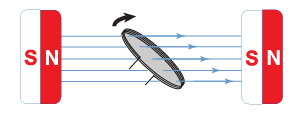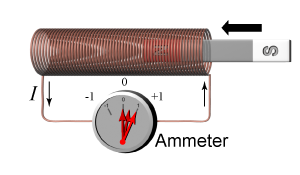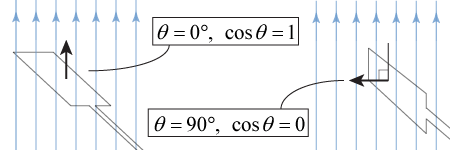|
Electric current can be created by a process called electromagnetic induction—by changing the magnetic flux through a conducting loop. The flux is the product of the loop’s area, magnetic field strength, and orientation of the loop relative to the field. Faraday’s law of induction tells us how much voltage will be generated. A generator uses induction to change mechanical work into electrical energy. A transformer uses the changing magnetic flux caused by changing voltage in one wire to induce a changing voltage in another wire. 
|
|
magnetic flux, Faraday’s law of induction, electromagnetic induction, Lenz’s law, electrical generator, transformer
|
|
|
|
Review problems and questions |
|

- The figure represents a simple electrical generator. Mechanical forces (such as wind) cause a wire coil to rotate in the presence of a magnetic field. Suppose that the rotation rate is beyond your control but that you can modify the properties of the generator itself. List three ways you could increase the voltage it produces.


|
You could increase the generator voltage by (a) increasing the loop diameter, and hence area; (b) increasing the number of loops; or (c) increasing the strength of the magnetic field in which the loop is spinning. 
|
- George’s electrical toy requires two 1.5 V AA cells (in series, for a total of 3 V). He only has one AA cell, but he has a transformer with a 2:1 turn ratio. Can he use his toy?


|
No, George cannot use the toy even though the turn ratio seems to fit. Transformers are intended only for use with alternating current, but the cell provides (and the toy requires) direct current. 
|

- Marcia inserts the N pole of a bar magnet into the right side of a wire coil and induces a temporary positive current. Would she induce (+) or (−) current if she
- inserted the S pole into the right side of the coil?
- inserted the N pole into the left side of the coil?
- inserted the S end into the left side?


|
- She would induce negative (−) current.
- She would induce negative (−) current.
- She would induce positive (+) current.

|

- A loop of wire rests at right angles to a uniform, upward-pointing magnetic field. The loop is 20 cm wide and 60 cm long. The coil begins to turn and then stops after rotating 90°. The magnetic field has a strength of 0.1 T. What is the magnetic flux through the loop in each of the states shown here?


|
 Answer:
Answer: - ΦB = 0.012 Wb.
- ΦB = 0 Wb.
Solution:
The magnetic flux is the product of the loop area, the magnetic-field strength, and the cosine of the angle between two vectors: the magnetic field and the “normal”—a vector that is perpendicular to the loop. (The normal is the arrow emerging from the center of the loop.)
- In this case, the normal and the field are aligned, and the flux has its maximum possible value for the specified loop dimensions and magnetic field:
- In this case, the normal and the field are at right angles. (More intuitively, note that the magnetic field lines skim the loop rather than pass through it.) Consequently, the cosine of the angle between these vectors is zero, and the magnetic flux is likewise zero.

|
Take a Quiz |

